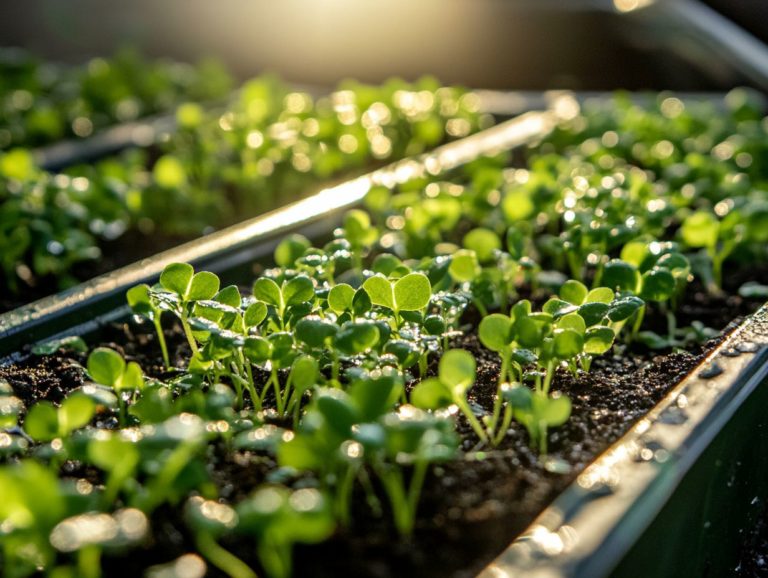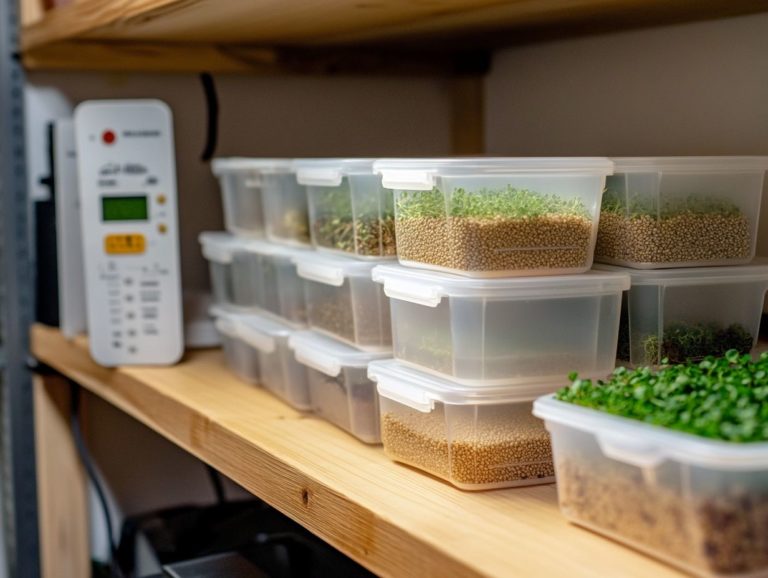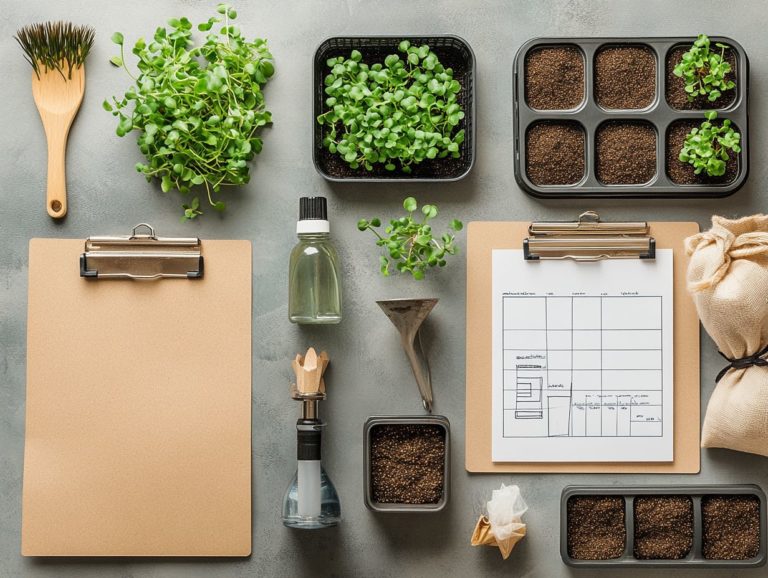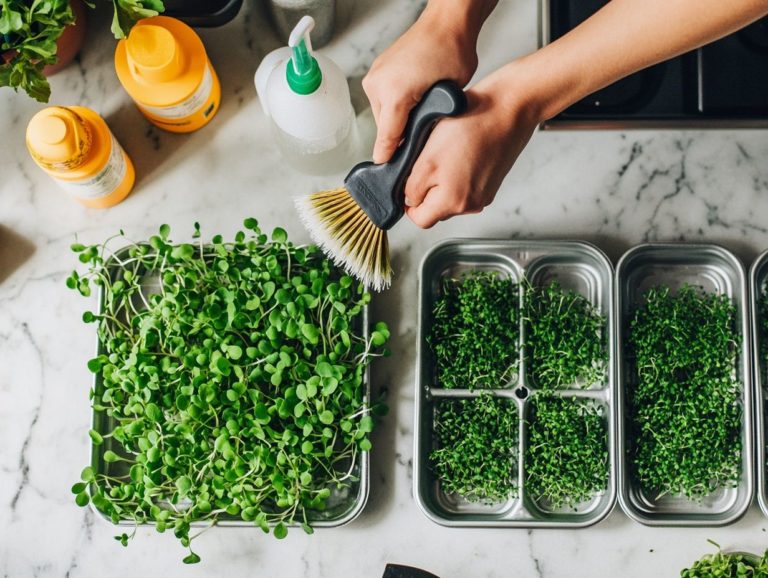Choosing the Right Trays for Microgreens
Ready to elevate your meals with vibrant, nutrient-packed microgreens? Let’s explore how to grow them!
Microgreens are delightful little plants that burst with flavor and are brimming with nutrients. They make a top pick for anyone who prioritizes health and wellness, as well as enthusiastic home gardeners.
Growing these miniature greens offers substantial nutritional benefits and helps you save a few bucks at the grocery store. The secret to cultivating microgreens successfully lies in choosing the right trays.
This article dives into the various types of trays available, outlines important factors to consider when making your selection, and shares essential maintenance tips. Whether you re an experienced gardener or just beginning your journey, you ll uncover valuable insights to ensure your microgreens thrive beautifully.
Contents
- Key Takeaways:
- Benefits of Growing Microgreens
- Types of Trays for Microgreens
- Factors to Consider When Choosing Trays
- Best Trays for Different Types of Microgreens
- Tips for Maintaining and Cleaning Trays
- Frequently Asked Questions
- What are the different types of trays available for growing microgreens?
- What material should I look for when choosing trays for microgreens?
- How do I determine the right size of tray for my microgreens?
- Can I reuse my trays for multiple batches of microgreens?
- What special features should I consider when choosing trays for microgreens?
- How many trays do I need for growing microgreens?
Key Takeaways:
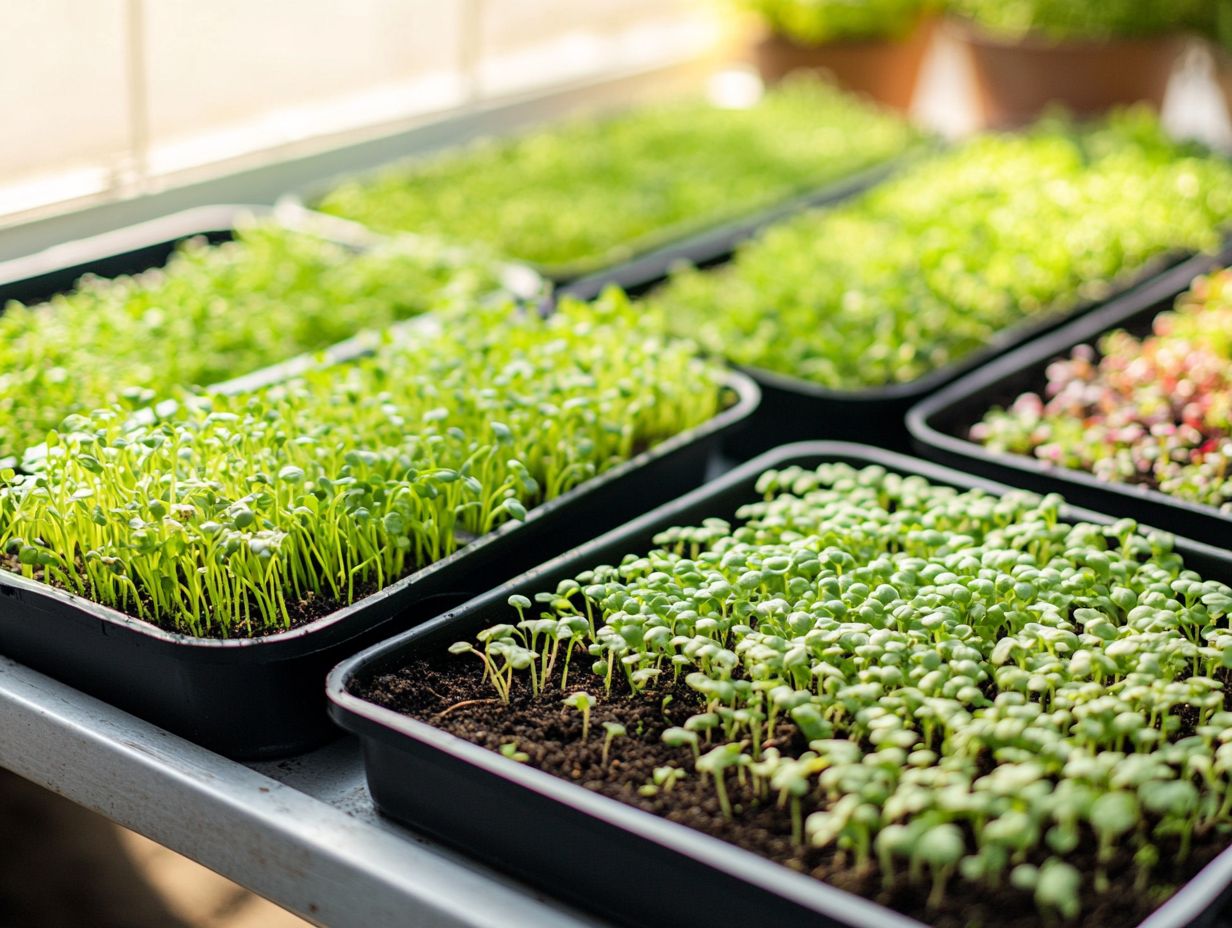
- Select strong trays that allow water to drain properly for optimal microgreen growth and easy maintenance.
- Consider the size of the trays and the specific variety of microgreens to ensure proper spacing and growth.
- Regularly clean and maintain trays to prevent mold and bacteria growth, extending their lifespan and saving money in the long run.
What are Microgreens?
Microgreens are young, edible plants that you can harvest at an early stage of growth, usually between 7 to 21 days after they germinate. You ll often find them enhancing salads, sandwiches, and serving as delightful garnishes.
Popular varieties like Pea Foxy and Rapeseed can thrive in various settings, from urban farms to home gardens. With the growing focus on healthy eating, cultivating microgreens has become an accessible and rewarding endeavor for both home gardeners and urban farmers.
These tiny greens are not just a feast for the eyes; they re bursting with flavor and nutrients. They progress through distinct stages, starting with germination and finishing with the first set of true leaves.
In terms of cultivation, your choice of soil or growing material is crucial and significantly impacts growth rate and overall plant health. You might opt for coconut coir, peat moss, or specially formulated seed starting mixes to create the perfect environment for your microgreens. Utilizing the essential tools for microgreen growing success can further enhance your growing experience.
Beyond their culinary appeal adding vibrancy to gourmet dishes or blending seamlessly into nutritious smoothies microgreens also support sustainable agriculture. They maximize space and resources, making them a smart choice for both small and large-scale farming practices.
Benefits of Growing Microgreens
Growing microgreens presents a wealth of advantages that you ll find hard to resist. Not only do they boast enhanced nutritional value, but they also provide significant cost savings and thrive even in limited spaces making them perfect for urban and organic farming practices.
These petite powerhouses are packed with nutrients and can be cultivated rapidly and effortlessly, whether in the comfort of your home or in small urban farms. With microgreens, you can enjoy a fresh supply of greens all year round.
Nutritional Value and Cost Savings
Microgreens are celebrated for their remarkable nutritional benefits, often packing higher concentrations of vitamins and minerals than their fully grown counterparts. This makes them an outstanding choice for health-conscious individuals seeking budget-friendly methods to elevate their diets through home cultivation.
Take, for example, a simple serving of broccoli microgreens; it can provide up to 40 times more vitamin E than mature broccoli, along with generous amounts of vitamins A, C, and K.
These tiny nutritional powerhouses also contain essential minerals like iron and magnesium, which are vital for your overall well-being. Cultivating them at home not only simplifies access to these nutrients but can also lead to significant savings compared to splurging on pricey organic produce.
By investing a modest amount in seeds and some basic equipment, you can effortlessly incorporate a fresh, nutrient-rich addition to your meals without straining your wallet. Don’t wait! Start your microgreen garden today and enjoy fresh greens in just a few weeks!
Types of Trays for Microgreens
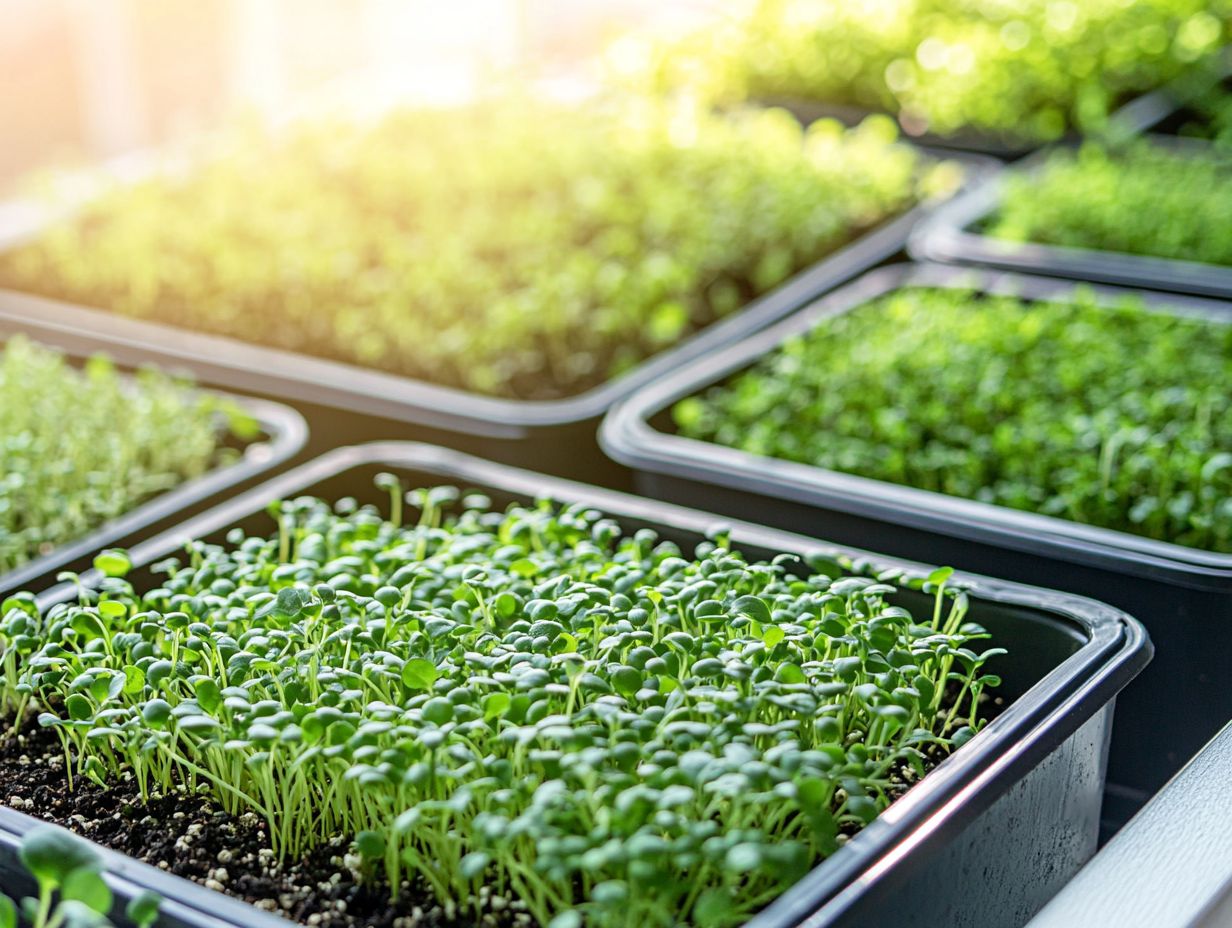
Choosing the right type of tray for growing microgreens is paramount for successful cultivation. It significantly influences drainage, soil volume, and overall growth conditions.
You have various options available, including planting trays, watering trays, and specialized trays designed for hydroponics. For optimal growth, consider using the best substrates for microgreen growing. Each type offers unique benefits, allowing you to tailor your approach for the best results.
Comparison of Different Tray Materials
The materials you choose for growing trays can greatly impact your success in cultivating microgreens. Options like plastic containers and biodegradable alternatives each have their own advantages considering weight, cost, and drainage effectiveness is crucial.
Plastic trays are known for their durability and resistance to wear, making them suitable for repeated use. However, it s important to consider their environmental impact if not recycled properly.
On the other hand, biodegradable options are a more eco-friendly choice as they break down over time. Yet, they may compromise some durability and can lead to drainage challenges if the soil retains excess moisture. For those looking to optimize their growing experience, understanding how to choose the right container for microgreens is essential. Striking a balance between longevity and environmental consciousness is key for maintaining effective drainage systems, promoting healthy root development, and preventing waterlogging during your microgreens journey.
Factors to Consider When Choosing Trays
When choosing trays, focus on size, drainage, and reusability. These factors will boost your growth conditions and save space!
Conducting a thorough comparison of trays will help you identify the most suitable options for different microgreen varieties and the specific cultivation spaces you have in mind.
Size, Drainage, and Reusability
The size of your growing trays is crucial for determining how many microgreens you can cultivate. Proper drainage holes are essential to prevent overwatering and root rot, which can quickly derail your efforts.
When selecting trays, consider reusability it s a smart choice that supports sustainable practices and leads to long-term cost savings, especially for hydroponic setups.
Choosing the right dimensions is vital. Larger trays can accommodate more plants but may require additional space and resources. Smaller trays limit your yield but are typically easier to manage. In hydroponic systems, efficiency is key; adequate spacing and drainage are paramount. For those interested in maximizing their efforts, exploring the best containers for microgreen cultivation can be game-changers, allowing plants to absorb moisture as needed and enhancing your watering efficiency.
A practical tip: experiment with various tray sizes and different types of microgreens. Additionally, considering how to choose the right soil for microgreen growth will provide you valuable insights on how to optimize both space and resource use effectively.
Best Trays for Different Types of Microgreens
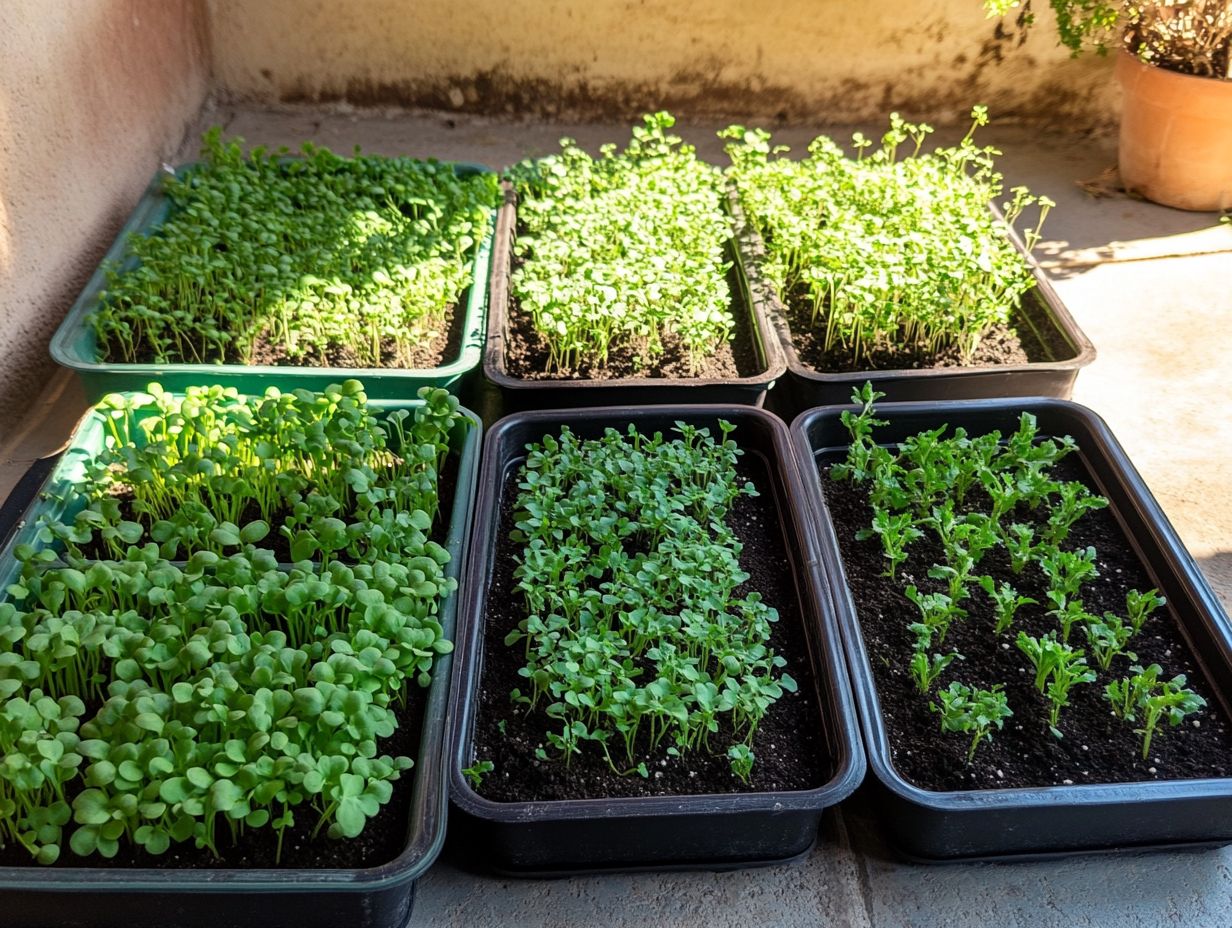
Selecting the ideal trays for various microgreen varieties is essential for maximizing growth and yield. With a range of planting and watering trays available, you can cater to the unique needs of each plant.
By understanding the specific requirements of popular microgreens, you can make informed choices by referring to how to choose microgreen varieties for your garden that elevate your home cultivation experience to new heights. Start your microgreen journey today!
Recommended Trays for Specific Varieties
When cultivating specific microgreen varieties, especially those from MP Seeds, choosing the right trays to match their growth patterns is crucial. The perfect combination of soil and tray can set the stage for a robust and thriving microgreen harvest.
For instance, varieties like basil, radish, and sunflower flourish in shallow trays that promote adequate drainage and airflow. Using well-aerated soil, such as coconut coir or organic potting mix, enhances drainage and delivers essential nutrients tailored for these microgreens. To maximize freshness, it’s also important to learn about the best methods for storing microgreens.
In contrast, leafy greens like arugula and mizuna thrive in deeper trays for better root development. Understanding the compatibility between your chosen trays and soil types ensures optimal moisture retention and prevents overwatering. For more information on using sprouting trays for microgreens, this knowledge ultimately leads to a bountiful and flavorful microgreen yield.
Tips for Maintaining and Cleaning Trays
Maintaining and cleaning your trays is essential for successful microgreen cultivation. This keeps diseases away and helps your microgreens thrive!
By employing effective cleaning techniques and routinely inspecting drainage systems, you can significantly extend the lifespan of your growing trays and ensure optimal conditions for your microgreens.
Proper Care and Maintenance Techniques
To achieve exceptional results in microgreen cultivation, implement proper care techniques with an ongoing focus on drainage holes and managing the soil. This proactive strategy will lead to healthier plants and increased yields.
Monitoring the moisture levels in your soil is paramount. Most microgreens flourish in a consistently moist environment. By establishing a watering schedule that aligns with their growth stages, you’ll promote robust development and vitality in your crops.
Choosing the right soil, such as a high-quality potting mix or specially formulated growing mats, helps with moisture retention and provides essential nutrients for your microgreens. For more detailed guidance, check out this resource on how to grow microgreens in shelves.
Paying close attention to drainage holes is crucial. Letting excess water escape is key to keeping your plants healthy and happy, preventing root rot and other issues that can compromise their health. This balanced approach will cultivate a thriving microgreen ecosystem, facilitating optimal growth and maximizing harvest quality. For more insights, check out our guide on harvesting microgreens: tools of the trade.
Frequently Asked Questions

What are the different types of trays available for growing microgreens?
There are three main types of trays: shallow trays, deep trays, and multi-tier trays. Shallow trays are versatile and common, while deep trays provide more space for root growth. Multi-tier trays are perfect for growing larger quantities of microgreens simultaneously.
What material should I look for when choosing trays for microgreens?
The most common materials are plastic, metal, and bamboo. Plastic trays are lightweight, durable, and affordable. Metal trays are sturdier and long-lasting, while bamboo trays are a sustainable and eco-friendly option.
How do I determine the right size of tray for my microgreens?
The size depends on the type of microgreens and the amount you want to harvest. Shallow trays typically measure 10×20 inches, while deep trays range from 4×8 inches to 10×20 inches. Consider the final height of your microgreens and the space they need to grow when choosing the tray size.
Can I reuse my trays for multiple batches of microgreens?
Yes, trays can be reused for multiple batches. It’s important to clean and sanitize them between uses to prevent bacteria and mold buildup. Plastic trays can be washed with warm soapy water, while metal and bamboo trays can be wiped with a disinfectant solution.
If you have more questions or want to share your experiences with growing microgreens, feel free to reach out! Start your microgreen journey today and explore more resources to enhance your skills!
What special features should I consider when choosing trays for microgreens?
Look for trays with drainage holes, humidity domes, or ridges for air circulation. These features help regulate moisture and fight mold, but they are not essential for growing microgreens successfully.
How many trays do I need for growing microgreens?
Your tray needs depend on how many microgreens you want to harvest and the frequency of your harvests.
Start with a few trays, then increase the number as you gain confidence and experience in growing.

